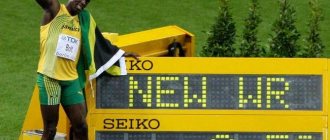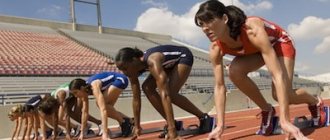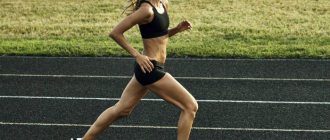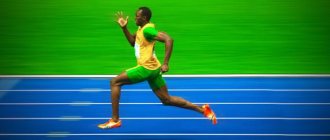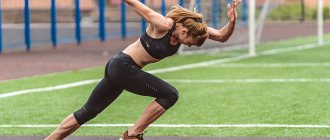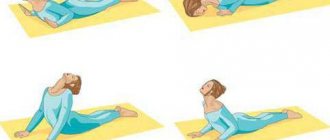The 100-meter run is a sports discipline that belongs to athletics and is quite common. It is this distance that is run in all schools and other educational institutions, when passing the GTO standards, and the discipline of one hundred meters is included in the Olympic sports.
If you want to learn correctly and run this segment easily and simply, then this article will tell you how to learn how to quickly run 100 meters. It is worth noting that a person who is not sufficiently prepared will not run this segment at a sufficient level. Further in the article we will provide you with the best tips and exercises for running correctly.
Start. Low start from the pads
Before learning to start from the blocks, you need to master starting from a falling position. Stand up straight, hands at your sides, and begin to lean forward. Take your first step just before you fall. The leg you take a step with will be the swing leg. At the moment of starting from the blocks, it will be at the back.
The next step is to start from a fall position from a low start. Lean forward, bending in half. The swing leg is slightly behind the pushing leg. Lower your arms down, but don't touch the track. Lean until you start to fall, and only then start moving forward.
Now you can start training to start from the blocks.
Installation of pads
We install the base of the pads, retreating from the starting line by the length of one foot. Make sure that it is exactly in the middle of the running strip. Step on the base to improve its grip on the surface.
We install the first block at a distance of two feet from the starting line. The second one is one foot from the first block or three from the starting line.
The angle of the pads is set individually. Typically, for the push leg, which is closer to the starting line, the block is set to the bottom or second to last position. The block for the swing leg is installed in a higher position.
You need to approach the pads from the front, not from the top. Stand in front of them, place your hands on the floor, then put your feet on the block and lower your knees.
Starting from the blocks
At the command “Start!” take the correct position on the blocks. The weight is evenly distributed between the five supports: arms, feet and knee of the swing leg. The hands should be straight in front of the starting line, resting on the surface with the thumbs and forefingers.
At the command “Attention!” Press your soles firmly into the pads and lift your pelvis. Keep your body straight. The head should be tilted down and the gaze directed towards the track. The center of gravity is transferred to the hands and feet.
At the start signal, begin an instant, explosive movement. Push off strongly from the surface, make a quick swing with bent arms. Straighten your front leg sharply and at the same time take a wide step with your back leg.
Starting run
A good start gives you the advantage of a fast starting run. The take-off run is the first third of the distance, which is covered at 90-95% of the maximum speed. The higher the runner's qualifications, the larger part of the distance is the run-up.
After the start, the body is in a forced bent state. Remember that the first steps of acceleration should be frequent, and the stride length should be optimal to maintain the selected body inclination. Don't try to stand up completely straight during the first moment of running. If you immediately straighten up and look forward, you will lose time and conditions for an effective run. Straighten your body gradually, over the first 7-10 steps of the movement.
How to run the distance
At the third stage of the distance - approximately 20-30 meters after the run - you need to move at maximum speed. The arms are bent at the elbows and move intensively along the body. Do not lift them high, try to work with your hands in the direction of movement. Your running technique should be familiar. Don't try to artificially increase your stride length by throwing your leg forward. Your powerful movement should come from your hamstrings and glutes.
Pay attention to some points that will help you run at maximum speed:
- The feet should be on the same line, this promotes better coordination of movement.
- Try to place your feet with your toes forward for better push-off.
- When both legs are in flight, the hip of the swing leg should be perpendicular to the track. This movement develops speed due to inertia.
- When your foot touches the track, your knees should be together, or the knee of your swing leg should be slightly ahead of your supporting leg. This will help reduce stance time and increase speed.
- in the full support position, when the foot is directly under the body, the leg is slightly bent. The correct position of both legs is the conventional number “4”.
- At the moment of takeoff, the body is in a natural position, the pushing leg is slightly bent at the knee. The vertical nature of repulsion provides a high flight trajectory and increased speed.
https://youtu.be/—Kg8eSs_tY
Jedi 5 km program in 25 minutes
At this stage, it is necessary to develop the “explosive power” of the legs, and develop it to accelerate at various parts of the distance. To do this, we include several exercises in the program. These are frog jumps, high jumps, and full squat jumps. Technique for performing “frogs”: from a full squat, straightening up, we jump up, landing on our toes, and immediately take the starting position in a full squat. High jumps are jumps with the legs pulled to the chest from a standing position. Jumps in a full squat are performed without straightening the legs, by pushing both legs at the same time, the length of one jump is one to two feet. 1 day. We gradually increase the distance from 11 to 13 km at an average pace. Strength exercises with an emphasis on the muscles of the legs, back, and core. Jumping exercises - at least 30 repetitions of each exercise.
Day 2. 2 km warm-up run. 7 sets of 800 meters of running at 90% of the speed for a distance of 5 km, in a time of no more than 3:40 minutes. Rest between segments no more than 60 seconds. During rest, do 20 squats. Run 2 km to cool down.
Day 3. 2 km warm-up run. 5 sets of 400 meters, with maximum acceleration. Rest at least 4-5 minutes for every minute of running. 3 sets of interval running for 1 km - alternating 100 meters of acceleration and 100 meters of running at a slow pace, resting no more than 2-3 minutes between sets. 2 km for a cool down. After 5-6 weeks of training, 2 days before training, you need to run 5 km against the clock. After we get a time of 25 minutes, we move on to the next program.
Finish throw
During the last stage of the race, the sprinter's speed usually drops by 3-8%. But the close finish is not a reason to pause deliberately. Instead, brace yourself for the final throw. The athlete with the highest running endurance wins the competition.
The end of the course is usually indicated by a ribbon that runs along the finish line. There are two ways to finish : when the sprinter touches the ribbon with his chest or shoulder. Both methods provide approximately equal opportunities to be the first to reach the finish line. The choice depends on the athlete's preferences.
The so-called “ chest throw ” is performed as follows: at the last stage of the race, sharply lean your chest forward, throwing your arms back.
To touch the finishing tape with your shoulder , you also need to lean forward while turning your shoulder towards the tape.
With both methods, the movement technique is the same: the runner shifts the center of gravity forward, while the upper body accelerates and the lower part slows down slightly. After contact with the finishing tape, you must sharply throw your swing leg forward. This will help avoid falling. “Stepping” on the leg shifts the center of gravity of the body back, the runner’s speed drops, and he gradually switches to walking.
Sprinters who have not mastered either of these methods are advised to run the finish line at maximum speed, without thinking about throwing themselves at the ribbon.
Three exercises in one day
At the initial stage of searching for an answer to the question of how to learn how to quickly run 100 meters, you should definitely learn how to perform the starting push, because, as we said earlier, a lot depends on the start. To prepare it, you need to squat. To run fast, your calf muscles will help you. And to develop them, you must try yourself. In this case, jumping will also help, but not the usual ones, but using a bench or ladder. You must regulate the number of these jumps yourself, because it depends on your preparedness.
How to learn to run 100 meters fast? Exercise 3 involves completing a distance of 100 meters. To develop such strength, you need to run as fast as possible with certain weights, for example, tie a sled or a car tire.
Running training for sprint distances
The most important quality for winning a sprint is the ability to maintain high speed until the end of the distance, that is, special sprint endurance. To develop specialized endurance, you need to include running short distances at maximum intensity into your training plan.
When running at a 100-meter distance, the body's energy supply occurs through the creatine phosphate and lactate systems. During the first 6-8 seconds of the race, maximum acceleration is provided by the creatine phosphate system. The lactate system allows you to maintain your speed until the finish line.
Starting Acceleration Training
The body must work with maximum load for 6-8 seconds. To do this, run segments of 30-60 meters at maximum speed. If you run 15 times 30 meters, take breaks of 6-7 minutes. This is an important condition for training the creatine phosphate system. Try running fast with an additional load (tire or parachute).
Endurance training at a distance
We take longer running segments, from 60 to 150 meters, but the rest between repetitions should be minimal.
For example:
- 10-15 times 60 meters at a speed slightly below maximum
- rest between repetitions 1-1.5 minutes
- walk or jog back.
You can also run 10 times 100 meters or 7 times 150 meters instead of 60-meter segments.
It is better to alternate such training: once a week you train the creatine phosphate system, once a week - the lactate system. Between intense workouts, run light cross-country to speed up recovery.
To understand exactly where the 100m running technique requires additional development, you can use the table for ideal distance covering .
| Speed, m/sec | 30 meters on the move | 30 meters, n/start | 60 meters, n/start | 100 meters, n/start | 200 meters, n/start |
| 12,0 | 2,5 | 3,5 | 6,4 | 9,9 | 20,2 |
| 11,5 | 2,6 | 3,6 | 6,5 | 10,1 | 20,6 |
| 11,1 | 2,7 | 3,7 | 6,6 | 10,3 | 21,0 |
| 10,7 | 2,8 | 3,8 | 6,8 | 10,6 | 21,6 |
| 10,3 | 2,9 | 3,9 | 6,9 | 10,8 | 22,0 |
| 10,0 | 3,0 | 4,0 | 7,0 | 11,0 | 22,4 |
For example, you run 30 meters from a low start in 3.6 seconds, and cover a distance of 60 meters in 6.8 seconds. At the same time, the total time for a distance of one hundred meters is 11.4 seconds. This means that it is necessary to train running endurance, since this particular section of the route is covered at the slowest speed.
This table is suitable for assessing your preparation and creating a training plan taking into account problem sections of the distance.
The development of special endurance in preparation for competitions is carried out with varying intensity. The heaviest load occurs as the competitive period approaches. During the competition, the intensity is maintained, and in the transition period it decreases.
Correctness and appropriateness of preparation
Many people often wonder how to learn to run a fast 100-meter distance. Anyone who really wants to get this experience should run some distance every day in order to increase endurance and strength in the legs.
Before learning how to run 100 meters quickly, you need to do a number of preparatory actions for your legs and other muscles:
- Stretching all muscle areas.
- Warming up all muscles so they are fully ready for running.
- Jumping rope.
This is also necessary to strengthen your legs. To know how to learn to run 100 meters quickly, you need to listen to the advice of athletes. They recommend walking and working out in the gym twice a week, and going for a run three times to pump up your legs.
Physical preparation for sprint distances
In addition to general physical training, in the preparatory period the volume of special running exercises (SBU) increases. SBU are aimed at training speed, strength and flexibility, as well as strength and running endurance.
SBUs are designed to selectively target specific muscle groups. These exercises also develop proper technique and skills that will help you run the 100m correctly.
The most effective running exercises:
Multi-jump, or “deer run”
This is running with wide steps, with a powerful push-off with the supporting leg, which ensures a slight hover (flight phase) of the body above the surface. You can alternate multi-jumps on one and two legs. Pay attention to the correct execution of this exercise:
- Land on your toes, not your entire foot.
- don't clench your hands into fists
- look forward
- fully straighten your pushing leg
Jumping exercises
Jumping from foot to foot
The movement occurs due to jumping. At the same time, the pushing leg straightens completely, and the thigh of the swing leg rises high.
Triple jump
Stand up straight, raise your arms up. Squat down and, helping yourself with your hands, push your body forward, as if jumping from a standing position. But you land on one leg and immediately take a wide jump with your other leg. Your third jump is to land on both feet. You can do the first two jumps with your right foot and land on both, and then repeat the exercise with your left foot.
Jumping off the blocks with two legs
This exercise promotes a quick and explosive start. Place the pads at the same level, and place a sports mat at a distance of 1.5 meters. Take a crouched position, then raise your pelvis, as at the start, and make a sharp jump.
Running with high knees
Your task is to keep your body slightly leaned forward and raise your knees to the level of your pelvis or higher. In this case, the heels should be under the knee, and not under the buttock, that is, the foot is parallel to the running surface.
Running with overwhelm
In this exercise, it is important to observe one condition: the heel rises to the buttock, but at the same time the toe points to the floor, and the knee automatically moves forward. There is no need to bend your knee too much and throw your heel back.
Running on straight legs
With this running technique, the legs are thrown forward at an angle of 45 degrees and are bent very slightly. The body is also slightly tilted forward, the abs are tense. Your task is to develop the maximum possible speed by quickly mixing and changing legs.
Mincing run
The movement occurs through short steps, landing on the forefoot. The body and arms are relaxed, the running speed is low.
"Bike"
The movement of the legs is reminiscent of pedaling when riding a bicycle. The thigh of the swing leg is raised high, and the lower leg is thrown forward. You need to land on the front of your foot, while making a quick “raking” motion with your foot down and back, as if you were trying to hold the pedal.
Lunges
The front leg is bent at the knee at a right angle, the toe of the back leg rests on the ground, the knee does not touch the surface. Push off and take a long step with your back leg, returning to your original position.
Remember that all exercises are done only after a preliminary warm-up.
How to run fast? Special exercises and training program
The 100-meter dash is one of the most common disciplines in athletics and an excellent form of physical activity. Every healthy person, if desired, can improve the speed of covering a distance if they set such a goal. We will help you understand all the intricacies and describe the training program in detail.
If you are wondering how to learn how to run 100 meters fast, first you must remember and take into account the following simple rules:
- Regularity. You need to run regularly, so you shouldn't be surprised by poor results if you pass the 100-meter standard once a year. You need to train at least 1-2 times a week, and then you will notice clear progress.
- Comfortable shoes and clothes. It is unlikely that you will learn to run 100 meters quickly in uncomfortable sneakers and a tracksuit. Invest in good running shoes with soft soles and clothes made of breathable fabric. With comfortable equipment, the distance will be much easier for you. You can read more about how to choose running shoes in a separate article.
- Wide step. Get used to running with long strides, helping yourself with your hands and moving your legs as quickly as possible.
Exercises to increase the pushing power of the legs and hone the correct technique will help you learn to run 100 meters quickly. They need to be performed at a fast pace without rest or breaks:
- Take dumbbells in your hands and press them to your shoulders. Squat down slowly and deeply, and then jump up sharply, pushing off the ground with all your strength. Both legs should push off at the same time. For additional load, you can stretch your arms with dumbbells up.
- To practice proper running technique, running with shin sweeps and running with high hips is useful. In the first case, the heels should touch the buttocks, and in the second, the knees should rise to chest level.
- Train the correct movement of your arms so that when running, only your shoulder joints are involved in the work. You can train in front of a mirror at home, simulating the movement of your arms when running fast. Do not clench your hands tightly into fists and make sure that your upper body does not follow your hand.
0-15 meters
Lower your head and swing forward slightly, placing your hands on the ground. When starting, push off strongly with your starting foot, directing the movement straight forward, not upward.
Regular squats will help you hone an effective start. Simply squat to the limit, and after a rest of about two minutes, repeat the set. Do just 4-5 sets in between and you will strengthen your push leg.
15-40 meters
When overcoming this section, the body should take a vertical position, and you should look forward and breathe strictly through your nose.
Performing the exercise requires the use of a platform or low bench. Stand on its edge with your toes and jump down, and then return with a sharp jump to the top.
Jump at maximum speed 10-12 times in 3 sets.
40-100 meters
This section will require maximum acceleration: run lightly and without overexertion. Start braking only after the finish line, not before.
You can train for maximum acceleration using the “trailer running” exercise. You will need a sled or sled with something heavy, which you attach to your belt with cables and run. The weight should be such that your stride length is not significantly shortened.
To learn how to run 100 meters, you need to have good strength and jumping training. Unlike middle- and long-distance running, the 100-meter dash requires virtually no endurance. However, in order to be able to run even 100 meters without slowing down, you will also have to train your speed endurance.
This type of training includes all strength exercises. It is very important for 100m sprinters to have very strong leg muscles. Therefore, all exercises performed in the power block are done with heavy weights.
— Deep squats with a barbell or dumbbells on the toes
— Leg press
— Raising the body on the toe with weights
— “Pistol” or squats on one leg with weights.
These 4 exercises can be called basic. There are many more, as well as variations of these strength exercises. But for basic general physical training, such an arsenal is enough.
It is better to perform exercises for 3 sets of 8-10 repetitions each.
— Jumping rope can be called basic exercises for all runners. They train both general and strength endurance, and also strengthen the calf muscles.
- Frog jumping. They represent jumping as high as possible from a squatting position. A basic exercise for a sprinter, as it works the front surface of the thigh and calf muscles, thereby increasing the athlete’s acceleration power from the start.
— High jumps on the spot or over barriers. Great for working the calf muscles.
- Jumping from foot to foot, improving the explosive power of the legs.
— Jumping on one leg also perfectly works the calf muscles and develops speed endurance.
Jumping work is most often performed in conjunction with running. Usually the training goes like this: 1-2 series of jumps are done, consisting of 5-7 exercises, and then the athletes begin running training.
100-meter runners need to develop speed qualities. To do this, you need to run at maximum speed for short periods with little rest.
Accelerations of 50 meters are best suited. Also, to develop speed endurance, many coaches recommend running 150 meters. Perform 10-15 runs.
Running 100 meters is an integral indicator that reflects a person’s speed.
MORE ABOUT: Why blood pressure rises sharply and very high
Therefore, this exercise was chosen as a control exercise for determining the motor quality “speed” among military personnel, law enforcement officers, students, vocational school students, schoolchildren, as well as in the sports and health complexes of the State Defense Department. Running 100 meters is a cyclic exercise of maximum power.
The effectiveness of successfully performing this exercise depends mainly on the power of anaerobic energy supply mechanisms, as well as on such components of speed-strength readiness as maximum isometric, high-speed dynamic and “explosive” strength of the leg muscles; mastery of running technique; speed of motor reaction, ability to start acceleration, level of maximum running speed over a distance, speed endurance, flexibility, etc.
To prepare for this control exercise, repeated and competitive methods are used. In training, primarily analytical improvement of individual phases of this exercise is used, and in competitions and tests, its holistic implementation is used. The exercise is conventionally divided into four phases: start, starting run-up, distance running and finish.
To practice the starting run (relative to a person’s independent speed ability), repeated running of segments of up to 30 m is used under a command and independently, but with mandatory control of the time of its running. Rest between runs until complete recovery (usually 2-4 minutes).
The running speed in the starting run increases gradually, due to the lengthening of steps and increasing their frequency. Important for increasing speed is the rapid lowering of the leg down and back (in relation to the body), as well as energetic, but not “fixed”, movements of the arms back and forth. A sharp, abrupt change in the length of steps disrupts the rhythm of movements and worsens the result.
Running speed can increase, especially in well-trained athletes, up to the 60th meter of the distance. Usually, by 4-5 seconds of running, 95-99% of the maximum speed level has already been achieved.
By the time the runner reaches the highest speed at a distance, the runner’s torso has a slight tilt forward, and the legs are placed elastically on the track, from the front of the foot.
Next, flexion and extension occurs in the knee and ankle joints.
When running along a distance, each runner establishes a characteristic ratio between the length and frequency of steps, which determines the running speed.
Vigorous movements of the arms should not cause the shoulders to rise upward. Keep your back straight, don't slouch.
When running, you must strive to relax those muscles that do not actively participate in the work at any given moment.
The end of the distance (finish) is recorded at the moment when the participant touches the imaginary finish plane with any part of the body (usually the chest), excluding the head, neck, arms and legs.
To quickly cross the finish line, at the last step you need to make a sharp lean forward.
Running the distance and finishing, to a certain extent, also depend on the speed endurance of the runner.
To train the various phases of the exercise, the following means can be proposed: 1. Running 10-20 m from the start: 3-5 times x 2-4 series (practicing the start and the starting run-up). 2.
Running 40-60 m from the start: 3-4 times x 1-2 series with arbitrary rest until breathing is restored (transition from the starting run to running along the distance and development of maximum speed). 3.
100 meter run standards (in seconds)
The world record of Usain Bolt , who ran 100 meters in 9.58 seconds in 2009, has not yet been broken by anyone. The 100-meter running standards are more flexible, but to achieve such results you will have to work hard.
| Men | Women | |
| Master of Sports (MS) | 10,4 | 11,6 |
| Candidate Master of Sports (CMS) | 10,7 | 12,2 |
| I category | 11,1 | 12,8 |
| II category | 11,7 | 13,6 |
| III category | 12,4 | 14,7 |
| I youth category | 12,8 | 15,3 |
| II youth category | 13,4 | 16,0 |
| III youth category | 14,0 | 17,0 |
